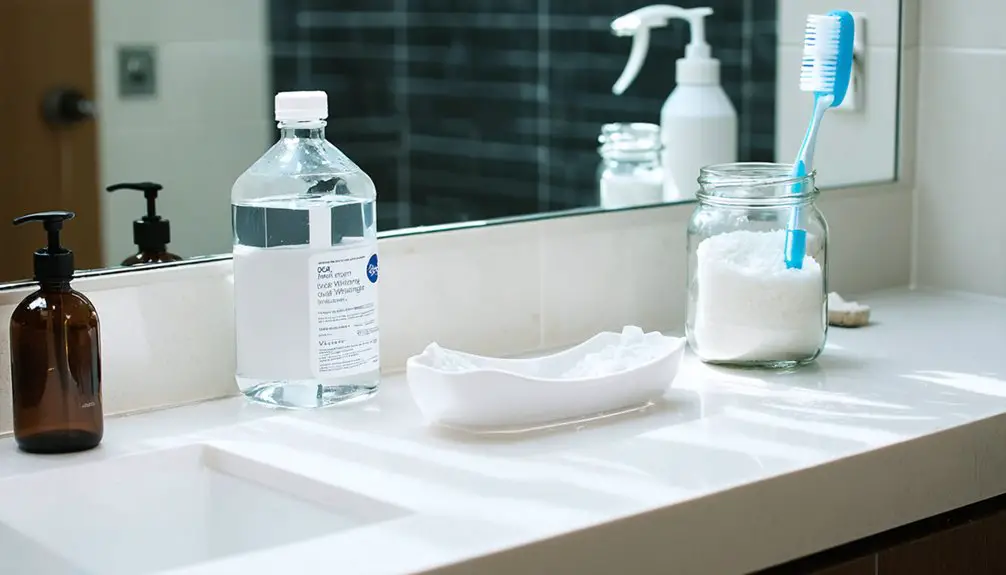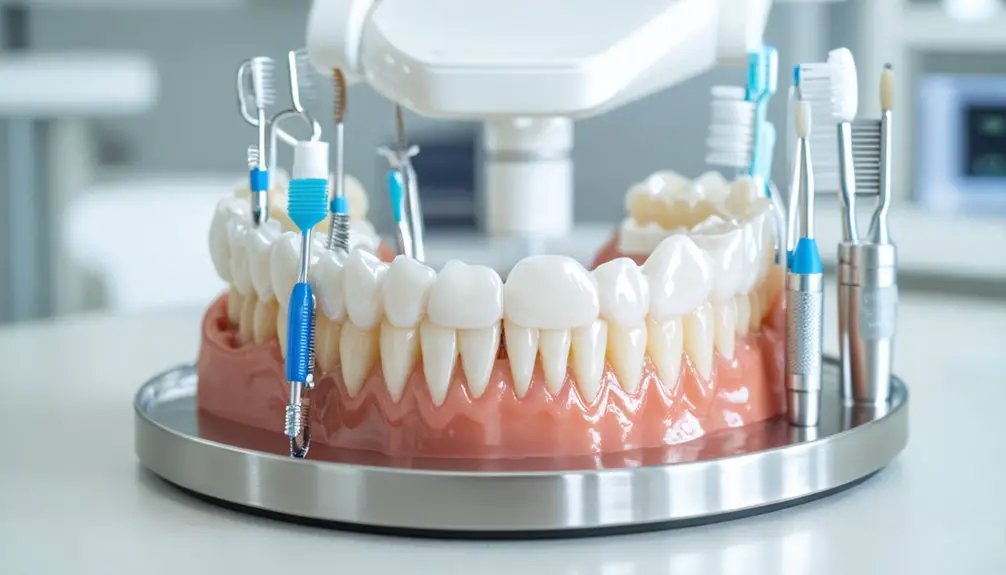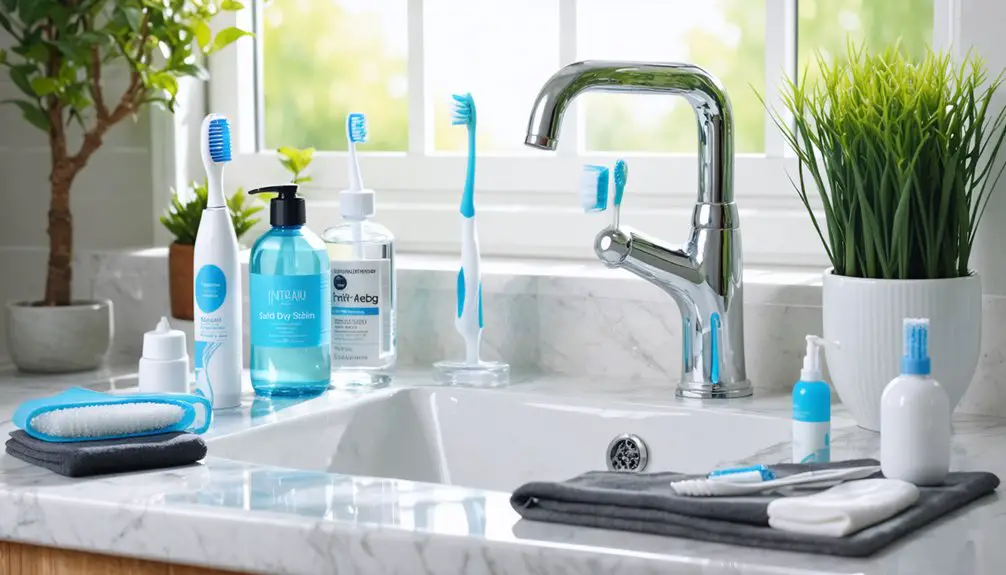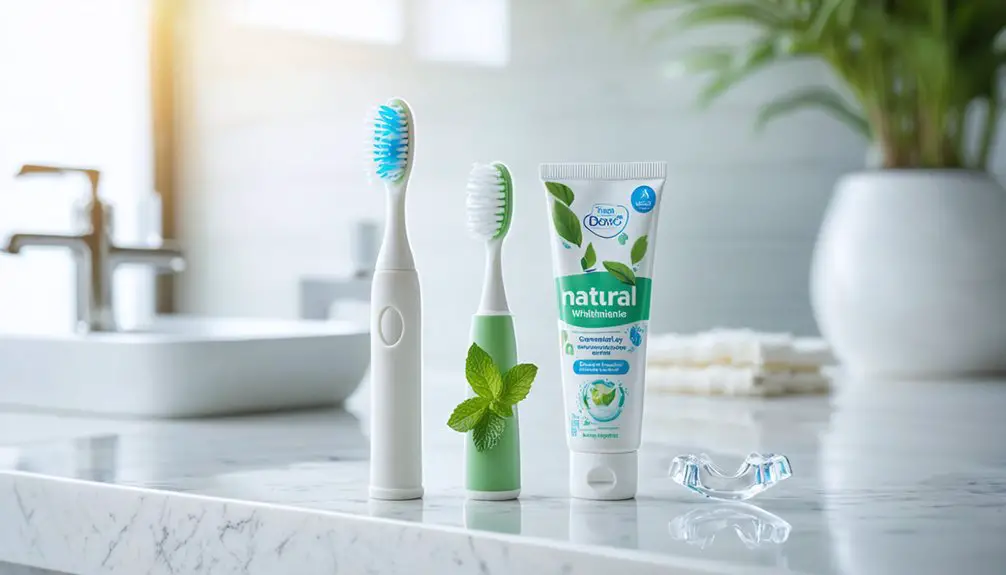To safely whiten your teeth at home, use only ADA-approved products containing controlled amounts of carbamide or hydrogen peroxide. Before starting, verify your teeth are free from cavities, gum disease, and plaque through professional cleaning. Monitor closely for sensitivity and gum irritation during treatment, and stop immediately if problems occur. Follow recommended application times and maintain good oral hygiene. Professional guidance can help you navigate additional whitening options and safety protocols.
Key Takeaways
- Choose ADA-approved whitening products containing safe levels of carbamide peroxide or hydrogen peroxide to ensure ingredient safety and effectiveness.
- Conduct a dental check-up before starting treatment to identify potential issues like cavities or gum disease.
- Follow product instructions carefully, including recommended application times, and stop immediately if experiencing persistent sensitivity or irritation.
- Avoid acidic DIY remedies like lemon juice, and limit natural whitening to baking soda mixed with diluted hydrogen peroxide twice weekly.
- Maintain results through regular brushing, flossing, and limiting staining substances like coffee and red wine after treatment.
Understanding Safe Home Whitening Products
When selecting at-home teeth whitening products, you’ll need to understand the key active ingredients and their safety profiles to achieve ideal results without damaging your oral health.
Look for products containing carbamide peroxide or controlled amounts of hydrogen peroxide, as these provide effective yet gentle whitening. Many inexperienced users risk damage by applying undiluted hydrogen peroxide directly to teeth. Choose products with the ADA seal of acceptance to guarantee ingredient safety and proven efficacy. Regular brushing and flossing with approved whitening toothpaste can help maintain results.
ADA-approved whitening products with carbamide or hydrogen peroxide offer safe, proven results while protecting your smile’s health.
For natural whitening options, consider a carefully measured mixture of baking soda with diluted hydrogen peroxide, used no more than twice weekly. Avoid acidic home remedies like lemon juice or vinegar, which can erode your enamel.
Custom-fitted trays from your dentist offer the most precise application method, while over-the-counter strips should fit properly to protect your gums from irritation.
Essential Pre-Treatment Safety Checks
Now that you’ve selected appropriate whitening products, completing thorough safety checks before treatment will protect your oral health and maximize results.
Start with a pre-treatment evaluation of your dental history, checking for untreated cavities, gum disease, or existing sensitivity. If you have any of these conditions, address them before proceeding with whitening.
Make sure your teeth are free from plaque and tartar by scheduling a professional cleaning or performing thorough brushing and flossing. A dental consultation is essential to assess your oral health and determine the most suitable whitening approach.
Conduct a patch test with your chosen whitening product to check for potential allergic reactions. Don’t proceed if you’re pregnant, breastfeeding, or have extensive dental work.
If you experience tooth sensitivity, use desensitizing treatments beforehand. Always read product instructions carefully to ensure proper application and avoid potential complications.
Step-by-Step Guide to Safe Application
Following proper application techniques guarantees both safety and ideal results when whitening your teeth at home.
Begin by keeping your teeth dry with tissue before applying any whitening product to maximize product effectiveness. When using strips, align them carefully along your gum line and press firmly for complete contact. Low concentration products are recommended when first starting a whitening regimen.
For tray systems, fill with a minimal amount of gel and insert securely over your teeth. Custom-fitted trays from your dentist ensure the most precise and comfortable application. Immediately wipe away any excess gel that contacts your gums.
Monitor your wearing time precisely – start with shorter durations if you’re sensitive, typically 30 minutes, and increase gradually as tolerated. You’ll need to maintain consistency with daily applications over 1-4 weeks, depending on your chosen product and stain severity.
Always rinse thoroughly after treatment and avoid staining substances for at least 30 minutes.
Recognizing Warning Signs During Treatment
To guarantee a safe whitening experience, you’ll need to monitor several key warning signs during treatment.
Watch for sensitivity symptoms like discomfort when consuming hot, cold, or acidic foods. If sensitivity persists beyond normal healing time, consult your dentist immediately. Using desensitizing toothpaste can help reduce discomfort during and after treatment.
Monitor your gums for signs of irritation, including redness, swelling, or burning sensations – these often indicate chemical exposure from whitening agents.
Check your teeth regularly for uneven coloring or unusual texture changes, as these may signal enamel damage. The active ingredient typically used is hydrogen peroxide, which penetrates tooth enamel to break down stains.
If you notice persistent throat irritation or stomach discomfort, stop treatment at once, as this suggests accidental gel ingestion.
Managing Common Side Effects
If you’re experiencing tooth sensitivity during whitening treatment, start by using desensitizing toothpaste and fluoride rinses to minimize discomfort.
You can take over-the-counter pain relievers like ibuprofen if the sensitivity becomes bothersome, but remember that these symptoms typically resolve within a week after stopping treatment. Using professional-grade trays prescribed by a dentist offers better protection and reduces the risk of side effects.
For gum irritation, rinse with warm salt water and consider applying topical numbing gel, while ensuring you’re using custom-fitted trays to prevent further contact between bleaching agents and your gums. It’s crucial to remember that attempting natural whitening remedies like lemon juice can damage enamel and worsen sensitivity issues.
Handling Tooth Sensitivity First
While tooth whitening effectively brightens your smile, sensitivity remains the most common side effect you’ll need to manage. The peroxide in whitening products temporarily demineralizes your enamel, exposing dentinal tubules that lead to nerve endings. This exposure, combined with potential nerve inflammation, creates that familiar sharp sensation when consuming hot, cold, or sweet items.
You can minimize discomfort by using fluoride toothpaste to promote remineralization, avoiding temperature-sensitive foods for the first 48 hours, and applying dentist-recommended desensitizing gels.
If you have pre-existing conditions like thin enamel or gum recession, you’ll need extra precautions. While sensitivity typically resolves within two weeks, consult your dentist if it persists longer.
Remember to limit whitening frequency and choose well-fitting trays to prevent excessive gum contact.
Reducing Gum Discomfort Safely
Successful teeth whitening requires careful attention to gum protection, since bleaching agents can cause temporary irritation and discomfort.
You’ll minimize risks by applying whitening gel precisely to tooth surfaces while avoiding contact with your gum line. Create a protective barrier using petroleum jelly on your gums before treatment.
Consider natural remedies and diet adjustments to support gum health during whitening. Reduce acidic foods and beverages, and maintain gentle brushing techniques.
If you experience redness or burning sensations, immediately discontinue treatment and rinse with warm water. Most symptoms resolve within 24 hours, but persistent irritation requires professional evaluation.
For ideal safety, consult your dentist before starting any whitening regimen. They’ll help select appropriate products and potentially recommend custom-fitted trays to prevent gel leakage onto sensitive gum tissue.
When to Stop and Seek Professional Help
Although home teeth whitening can be effective, recognizing when to discontinue treatment and seek professional help is essential for your oral health.
You’ll need to stop whitening and consult your dentist if you experience persistent tooth sensitivity, gum irritation lasting more than a few days, or oral burns and blisters from bleaching agents.
Monitor your whitening frequency and treatment duration closely. If you notice uneven results, poorly fitting trays, or signs of enamel damage like increased roughness, cease treatment immediately.
Seek professional evaluation if sensitivity interferes with daily activities or if gum inflammation persists despite reduced usage.
Additionally, schedule a dental consultation before starting any whitening regimen if you have pre-existing conditions like gum disease or unfilled cavities to prevent potential complications.
Maintaining Results Without Harming Teeth

You’ll need to monitor your teeth’s response to whitening treatments and stop immediately if you experience prolonged sensitivity or gum irritation.
To maintain results safely, brush twice daily with ADA-approved whitening toothpaste, floss regularly, and limit staining foods and beverages while incorporating tooth-strengthening foods like crunchy fruits and dairy products.
Professional dental cleanings every six months will help preserve your whitening results while ensuring your ongoing oral health isn’t compromised by maintenance efforts.
Safe Long-Term Methods
When maintaining teeth whitening results long-term, professional custom trays offer the safest and most reliable method for ongoing treatment. Your dentist will create trays from precise impressions, ensuring proper fit to prevent gel overflow and minimize gum irritation.
These custom trays, used with controlled whitening agents like carbamide peroxide, can last up to five years for continued maintenance.
To maximize safety and effectiveness, you’ll want to combine tray usage with protective measures. Apply fluoride treatments after whitening sessions, use remineralizing products, and avoid staining substances like coffee and red wine.
Schedule periodic touch-ups monthly or bi-monthly, following your dentist’s guidance. Professional oversight helps prevent enamel damage and sensitivity while maintaining your desired level of whiteness through controlled application of bleaching agents.
When to Stop Whitening
Recognizing the right time to stop whitening treatments is essential for protecting your dental health while maintaining results.
You’ll need to halt treatment if you experience persistent tooth sensitivity lasting beyond two weeks, notice signs of enamel erosion, or develop gum irritation and sores.
Monitor your whitening frequency carefully – limit in-office treatments to weekly intervals and home treatments to monthly sessions after your initial phase.
If you’re not seeing further improvement after several applications, it’s time to stop.
Watch for warning signs like unusual tooth pain or white spots on your enamel.
To maintain your results safely, space treatments 2-3 months apart, allowing sufficient time for enamel recovery.
Your treatment duration should always be guided by your teeth’s response and any sensitivity you experience.
Post-Treatment Dental Care Guidelines
Proper post-treatment care is essential for maximizing and maintaining your teeth whitening results. In the first 48 hours, avoid staining foods and beverages like coffee, tea, red wine, and dark sauces.
To maintain your bright smile after whitening, avoid dark foods and drinks for the first two days post-treatment.
Stick to light-colored foods and clear dental products to protect your newly whitened teeth. For post-treatment nutrition, drink plenty of water and wait 30 minutes after eating before brushing.
For sensitivity management, use toothpaste formulated for sensitive teeth and brush gently with soft bristles. If you experience discomfort, over-the-counter pain relievers can help.
Resume normal oral hygiene after 48 hours, including flossing and tongue cleaning. Schedule periodic touch-up treatments and maintain regular dental cleanings to preserve your results long-term.
Contact your dentist if you experience severe or persistent sensitivity.
Professional Alternatives for Sensitive Teeth

For those with sensitive teeth, professional whitening alternatives offer safer and more controlled approaches than standard over-the-counter treatments.
Your dentist can customize treatments with precise bleaching concentrations while incorporating desensitizing agents to protect your enamel and minimize discomfort.
Professional in-office options like Zoom Whitening provide quick results under careful supervision, while custom take-home trays offer gradual sensitivity management through lower-concentration gels.
Your dentist can adjust the strength based on your response and combine treatments with fluoride applications to strengthen enamel.
If you’re experiencing heightened sensitivity, consider specialized whitening toothpaste containing potassium nitrate and stannous fluoride.
These products gently remove surface stains while blocking nerve pain signals, making them ideal for maintaining results after professional whitening treatments.
Frequently Asked Questions
Can Whitening Products Cause Permanent Damage to Dental Crowns or Veneers?
While whitening products won’t permanently damage your crown durability or veneer longevity, they can cause surface changes and uneven coloring between your natural teeth and dental restorations over time.
How Long Should I Wait Between Professional Cleaning and Starting Home Whitening Treatments?
You’ll need to wait 24-48 hours minimum post cleaning timeline before starting home whitening treatments. For ideal results and reduced sensitivity, consider extending this to one week between sessions.
Does Charcoal-Based Whitening Toothpaste Effectively Remove Deep Stains Without Damaging Enamel?
You’d need a miracle worker, as charcoal’s effectiveness only reaches surface stains, not deep ones. Your enamel safety is at risk from its abrasiveness, potentially causing permanent damage.
Will Teeth Whitening Affect the Strength of Existing Dental Bonding Materials?
Yes, teeth whitening can compromise your bonding’s longevity and stability. You’ll notice reduced whitening compatibility with existing dental work, and bleaching agents may weaken composite-to-tooth bonds and create micro-cracks.
Can Medications Interfere With the Effectiveness of Teeth Whitening Products?
Yes, your medications can considerably impact whitening efficacy through intrinsic staining, saliva reduction, and direct chemical interactions. You’ll need to disclose all medications to your dentist before starting treatments.
References
- https://alpenglowdentists.com/what-safety-measures-should-you-take-when-using-whitening-products/
- https://www.canada.ca/en/health-canada/services/healthy-living/your-health/lifestyles/safe-use-home-tooth-whitening-kits.html
- https://www.dentistryofwestbend.com/teeth-whitening-risks-and-side-effects/
- https://www.gilaridgedental.com/safety-tips-when-using-teeth-whitening-products-at-home/
- https://www.goodrx.com/conditions/dental-care/is-teeth-whitening-safe
- https://bellevuedentaloasis.com/blog/teeth-whitening-ingredients-to-avoid/
- https://gloscience.com/blogs/blog/before-it-goes-in-your-mouth-check-your-ingredients
- https://www.lwdentist.com/diy-teeth-whitening-what-works-and-what-to-avoid/
- https://www.trysnow.com/blogs/news/teeth-whitening-ingredients
- https://mayfairefamilydentistry.com/what-health-issues-should-be-considered-before-teeth-whitening/



